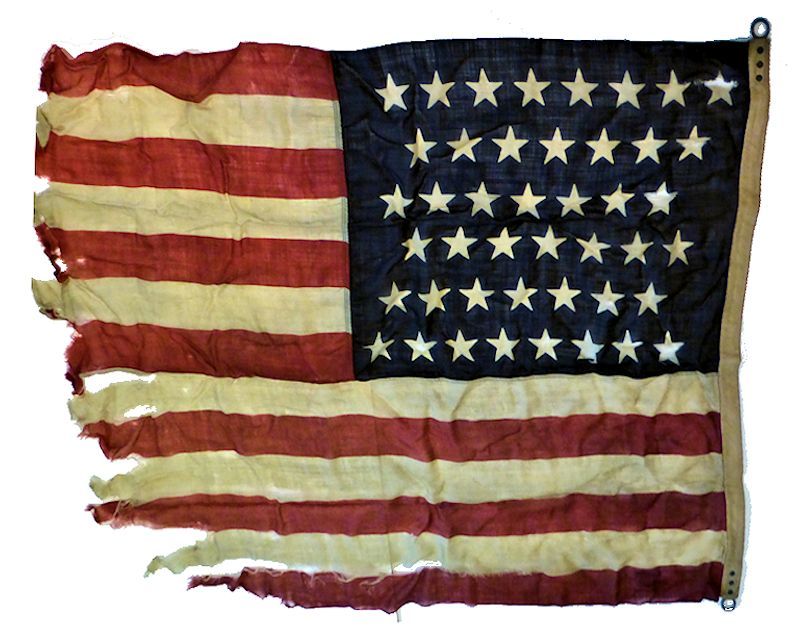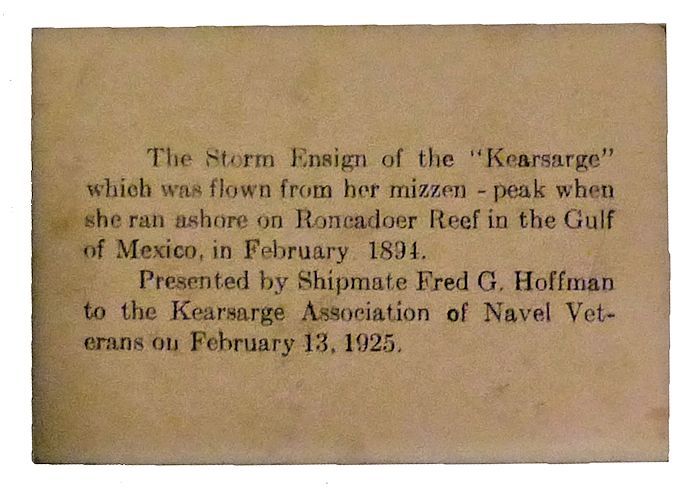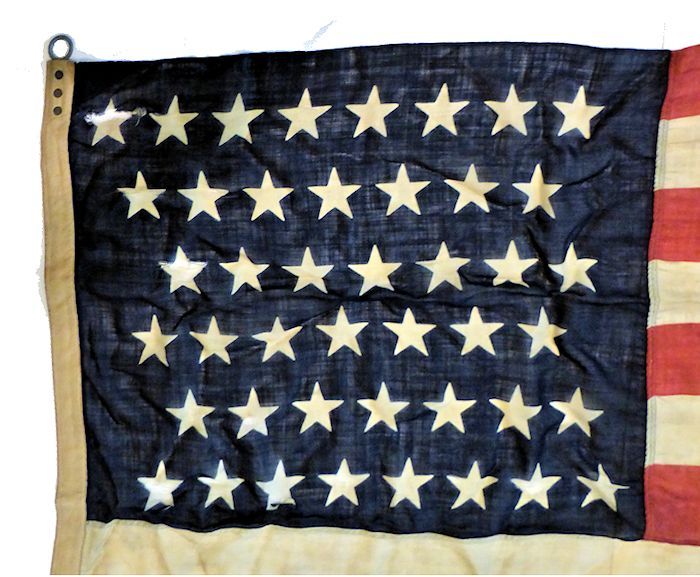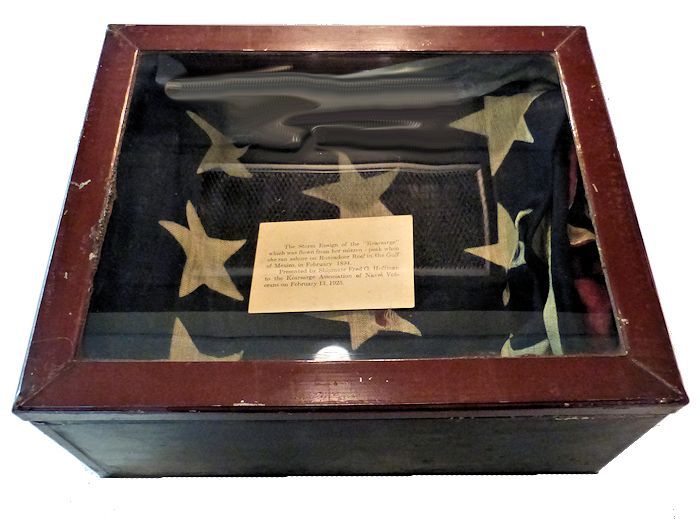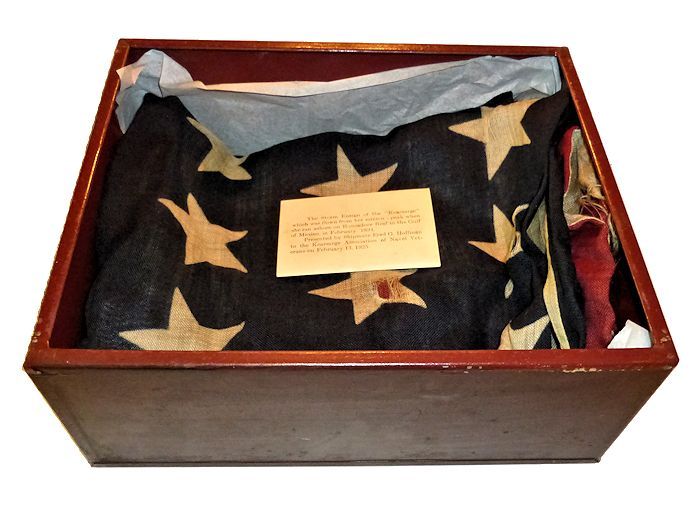SIZE 48“
x 56“ [4 ft x 4 ft 8 in]
Weight in box 5 lbs 13 1/2 oz
Presented
is the tattered Storm Ensign” that was flown by the first USS Kearsarge when she ran aground on Roncadoer Reef in
the Gulf of Mexico off the coast of Nicaragua on February 2, 1894. The flag was donated in 1923 by Fred G. Hoffman, a member
of the ship’s crew and of the association. The design of the 44 stars and 13 stripes is imprinted on the bunting with
colorfast dye, and the tabling along the hoist is of heavy duty duck with three rivets adding strength at its top and
bottom. The flag’s trailing edge is badly tattered with a loss of cloth and it is impossible to judge what its original
length may have been. There are no markings on the flag or grommets.=left>
This flag
pre-dates the standard sizes that were introduced in the early
1900’s, and adopted by the U.S. Navy. At that time, each flag was denoted by a number, and keyed to specified dimensions
with consistent sizes for each application.
STAGGERED
SIX ROWS OF STARS from the top down making 44 Stars total. This
Flag became the Official United States Flag on July 4th, 1891. A star was added for the admission of Wyoming (July 10,
1890) and was to last for 5 years.
8 stars
7 stars
7 stars
7 stars
7 stars
8 stars
METAL STORAGE
BOX houses the flag. The reddish brown paint is not waterproof, but is dry to the touch. The box is 12″W x 10″ D
x 5″H and weighs about 4 pounds.
|
Card providing the provenance of this flag
|
BRIEF HISTORY OF KEARSARGE: The first KEARSARGE was launched on 11 September
1861 by the Portsmouth Navy Yard, Portsmouth, NH; sponsored by Mrs. Henry McFarland, wife of the editor of the Concord Statesmen,
and commissioned 24 January 1862 with Captain Charles W. Pickering in command.
The Sloop of War KEARSARGE departed Portsmouth 5 February 1862 for the coast
of Spain to join in the blockade of Confederate raiders. Captain John A. Winslow, took command of the KEARSARGE on April 8,
1863, while she remained in European waters searching for raiders. Arriving in Cherbourg, France on 14 June 1864, she found
the Confederate Ship ALABAMA in port. On June 19, ALABAMA stood out of Cherbourg Harbor for her last action. Careful of French
neutrality, KEARSARGE’S new commanding officer, Captain Winslow, took the sloop of war well clear of territorial waters,
then turned to meet the Confederate cruiser. ALABAMA fired first but the battle quickly turned against her and within an hour
the ALABAMA had been reduced to a sinking wreck and her Captain Raphael Semmes struck his colors and surrendered.
KEARSARGE rescued the majority of the ALABAMA’s survivors; but Captain
Semmes and 41 others were picked up by a British yacht. Captain Winslow was promoted to Commodore and the New York Chamber
of Commerce honored him, the KEARSARGE, and her crew, mainly men from New Hampshire, for their victory.
The KEARSARGE returned to sea and the coast of Spain in April 1865 in search
of Confederate ships. After cruising the Mediterranean and the English Channel south to Liberia, the KEARSARGE returned to
the Boston Navy Yard in August 1866.
In January 1868 KEARSARGE sailed to serve in the South Pacific and along the
coast of South America to protect American interests for the next four years. She later performed similar duties in the Asiatic
waters of Japan, China and the Philippines. During this time she carried Professor Hall’s scientific party from Nagasaki,
Japan, to Vladivostok, Russia, to observe the transit of Venus.
The last assignment for the KEARSARGE was protecting American interests in
the West Indies, off Venezuela and along the Central Americas. On February 2, 1894, on Roncador Reef off the coast of Nicaragua,
the KEARSARGE was wrecked.
|
Closed
steel storage case shown above case with top removed
|
Many collectors
prefer military flags to show their age and history of use.
CONSTRUCTION:
The tabling is unmarked as are the two grommets The flag is entirely on a single piece of cotton cloth.
The stars are arranged in 2 rows of eight and 4 rows of seven making 44 stars in total.
